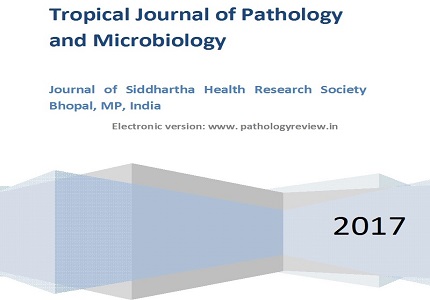Clinico-mycological study of Dermatophytosis at a tertiary medical center of Uttar Pradesh
Abstract
Background: Now day’s number of dermatophyte infection in general population is increasing. It is generally known as Tinea corporis, Tinea cruris, Tinea faciei etc.
Material and Methods: A prospective study was done to know the current clinical status of dermatophytic infection in patients attending the outpatient department of skin at a tertiary medical center. Mycological study of skin scraping was done in department of Microbiology. The data was interpreted by statics.
Result: In the present study, most common age group affected 21-30 years with 37.90%. Male to female ratio was 4.7:1. Dermatophytoses infection was found to be higher among manual worker (40.1%) and in lower middle class (52% cases). Tinea corporis and Tinea cruris were the most common clinical type (48%). KOH positivity was seen in78.8% of cases.
Conclusion: Dermatophyte infection is quite prevalent now days. It is more in middle age group with male preponderance. It is more commonly seen in lower middle class and mostly in manual workers. Tinea corporis et cruris is the commonest presentation.
Downloads
References
2. Chander J. Textbook of medical mycology 3r edition. New Delhi: Mehta Publishers; 2009.
3. Mackenzie DW. The extra-human occurrence of Trichophyton tonsurans var. sulfureum in a residential school. Sabouraudia. 1961 Jan;1:58-64.
4. Kane J, Smitka CM. A practical approach to the isolation and identification of members of the Trichophyton rubrum group. Pan Am. Health Org. Sci. Publ. 1980;396:121-134.
5. Rebell G, Taplin D. Dermatophytes, their recognition and identification. Coral Gables, Florida: University of Miami Press; 1970.
6. Young CN. Range of variation among isolates of Trichophyton rubrum. Sabouraudia. 1972 Jul;10(2):164-70. [PubMed]
7. Kane K, Krajden S, Summerbell RC, Sibbald G. Infections caused by Trichophyton raubitschekii: clinical and epidemiological features. Mycoses 1990;33:499-506.
8. Patwardhan N, Dave R. Dermatomycosis in and around Aurangabad. Indian J Pathol Microbiol. 1999 Oct;42(4):455-62. [PubMed]
9. Sen SS, Rasul ES. Dermatophytosis in Assam. Indian J Med Microbiol. 2006 Jan;24(1):77-8. [PubMed]
10. Kumar S, Malya PS, Kumari P. Clinico-Mycological study of dermatophytosis in a tertiary care hospital. International journal of sicentific study 2014;1(6):27-32.
11. Singh S, Beena PM. Profile of dermatophyte infections in Baroda. Indian J Dermatol Venerol Leprol 2003;69:281-3.
12. Chander J. Textbook of medical mycology 3r edition. New Delhi: Mehta Publishers; 2009.
13. Gupta S, Agrawal P, Rajawat R, Gupta S. Prevalence of dermatophytic infectino and determining sensitivity of diagnostic procedures. Int J Pharm Pharm Sci 2014;6(3):35-8.
14. B indu V, Pavithran K. Clinico-mycological study of dermatophytosis in Calicut. Indian J Dermatol Venereol Leprol. 2002 Sep-Oct;68(5):259-61. [PubMed]
15. Yadav A, Urhekar AD, Mane V, Danu MS, Goel N, Ajit KG. Optimization and isolation of dermatophytes from clinical samples and in vitro antifungal susceptibility testing by disc diffusion method. RRJMB 2013;2(3):19-34.
16. Bhatia VK, Sharma PC. Epidemiological studies on Dermatophytosis in human patients in Himachal Pradesh, India. Springerplus. 2014 Mar 9;3:134. doi: 10.1186/2193-1801-3-134. eCollection 2014.
17. Sarada D, Kumari PR. A study of Dermatomycoses. International Journal of advanced research 2015;3(1):582-8.



 OAI - Open Archives Initiative
OAI - Open Archives Initiative


